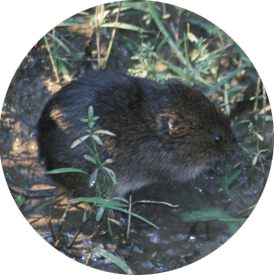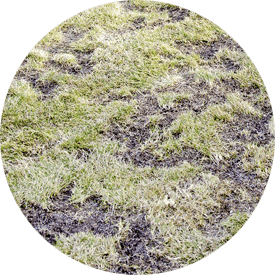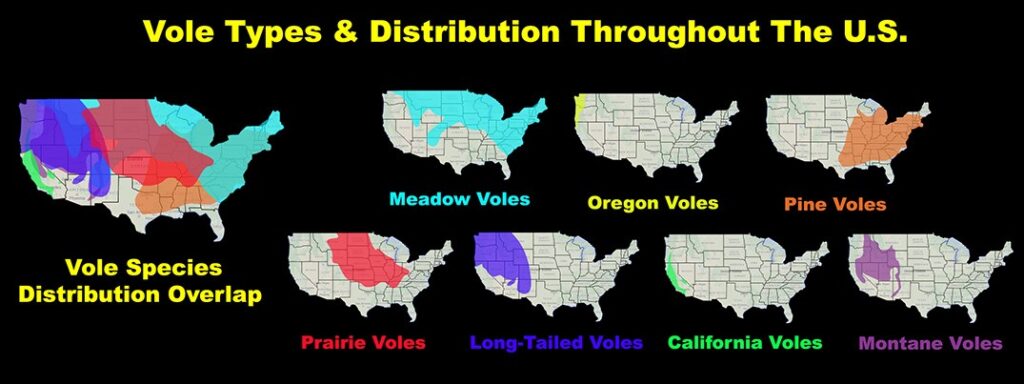Voles
Voles: When, Where, Who, What, How & Why

Who Are We Dealing With Here?
23 species of voles occupy the US, but only 7 of them (Prairie, Long-tailed, Meadow, Pine, Montane, and Oregon) are of significant concern for the economic damage they cause. Voles look very similar to a mouse which earned them the nick names “field mice” and “meadow mice.” Despite the similar appearance, there are important differences in their appearance and behavior. They are usually brown or gray stalky animals about 4-8 inches in length with short tails, short legs, small eyes, and ears that are not very visible.
A Glimpse Into Voles

The most prevalent voles in landscapes are the pine and meadow voles.The pine vole is about three inches long, weighs one ounce, and has chestnut hair, a short 1/2 inch long tail and tiny ears. Meadow voles are 5 1/2-7 1/2 inches long with gray to yellow-brown fur. You are more likely to see signs of voles than the voles themselves.
Look for their presence by locating their circular burrow entrances not more than 1″ – 1.5″ in size and by lifting mulch to reveal long narrow trenches or runways that are serpentine, and that wind around obstructions. Voles can burrow into the root systems of landscaping shrubs and trees, causing young specimens to experience dieback or to begin to lean. Pine voles will also gnaw on a tree trunk and at the base of a shrub known as girdling. In addition, voles damage flower bulbs and potatoes in the garden. A large portion of their diet comes simply from stems and blades of grass. And the runways they leave behind in the process make for an unsightly lawn.
Unlike many other small mammals, voles do not hibernate. Instead, they are active throughout the year. And depending upon where you live, voles can have four or five litters each year with an average of three babies per litter. Female pine voles have a gestation period of about 24 days. Due to this prolific ability to reproduce, vole populations grow quickly.
What damage do Voles Cause?

Turf damage (surface) – voles will feed on grass as well as rip and tear out blades of grass to create intricate runways through lawns. In areas of considerable snowpack, the voles will line snow tunnels with plucked grass to provide stability and insulation to their structures. After spring melts the snow, remaining tunnel systems will reveal concentrated areas of droppings, food storage, and nesting areas all separate from each other but connected through their maze of tunnels.
Turf damage (subterranean) – voles will burrow into and under retaining walls, homes, or other sturdy items or structures that provide protection from predators. They will also build relatively shallow subterranean runways for predator evasion, food storage, and nesting.
Ornamental damage – in addition to feeding on grasses, voles love to chew on and eat shrubs and bushes. Certain species of voles will also girdle trees (chew away the bark in a ring at the base of the tree) which can lead to loss of the plants being attacked and fed upon
Where Are Voles The Biggest Problem?

Where Are Voles The Biggest Problem?
Voles often go unnoticed, but once damage starts to surface, it is time to figure out which of the 4 main avenues caused the issue to arise.
• Native population – One of the most common causes of people entering the vole battling arena is the simple choice to build a home smack dab in the middle of a native vole population’s stomping ground. These voles shout the rally cry, “we were here first!” and will make you pay dearly for your intrusion.
• Habitat Destruction – Often times it is the draining of a pond, the breaking ground for a house nearby, or the development of adjacent land that will cause a population to have to flee their previous homes. Once these animals are on the move, they are likely to fancy your well-manicured lawn and landscaping.
• Population Expansion – In many instances it is simply a matter of time and population growth. If you notice vole damage within a mile of your home, you can expect at least a handful of voles to meander through your yard at some point. If you have a home waiting for them, they might just decide to stay.
• Unnatural Protection – What started out as a small family or pair of family of voles in a wild, undeveloped area may quickly sprout into a blossoming family tree ready to decimate your yard each winter. Voles are prolific reproduction machines. When given the right combination of plentiful food, lack of environmental stress, lack of adequate predation, and sufficient water; voles may have a population irruption raising the number of voles per acre from 7 to 4,000!
Why Eliminate Voles?
Voles can be frustrating to try and control, so why should we even try? The number one reason for controlling vole populations is the cost of their damage. As populations rise in density from 50 to hundreds to thousands per acre, the amount of damage they can do in a few months will surpass what nature can replenish. As we build habitats for dwellings, many vole populations are left without enough natural predators to keep the populations in check. It becomes necessary to put efforts into restoring balance. Despite setbacks and population spikes, regular and routine efforts should be maintained and promoted throughout neighborhoods.
The secondary motivator for staying on top of vole populations has to do with the secondary problems they bring with them. Besides the damage they will directly cause, they may also bring in fleas and ticks that may find you or your pets. They may also attract snakes or other unwanted predators that wish to eat them or inhabit their tunnel systems. These invasive predators typically cause more problems for home owners than help in controlling the vole population.
If your Minnesota home is under attack from voles, call the experts at Rove: 651-240-6363. Our courteous pest control specialists from one of our 4 offices: St. Paul, Minneapolis, Oakdale & Brooklyn Park will be able to assist.
Arizona Vole Control Service Areas
Massachusetts Vole Control Service Areas
- Vole Control in Framingham, MA
- Vole Control in Marlborough, MA
- Vole Control Milford, MA
- Vole Control in Shrewsbury, MA
- Vole Control in Southborough, MA
- Vole Control in Wellesley, MA
Michigan Vole Control Service Areas
- Vole Control in Commerce Charter Township, MI
- Vole Control in Detroit, MI
- Vole Control in Farmington Hills, MI
- Vole Control in Milford, MI
- Vole Control in Novi, MI
- Vole Control in Plymouth, MI
- Vole Control in South Lyon, MI
- Vole Control in Wixom, MI
Minnesota Vole Control Service Areas
- Vole Control in Lakeview, MN
- Vole Control in Brooklyn Park, MN
- Vole Control in Champlin, MN
- Vole Control in Eagan, MN
- Vole Control in Edina, MN
- Vole Control in Golden Valley, MN
- Vole Control in Inver Grove Heights, MN
- Vole Control in Minneapolis-St.Paul, MN
- Vole Control in Oakdale, MN
- Vole Control in Plymouth, MN
- Vole Control in Rochester, MN
- Vole Control in Roseville, MN
- Vole Control in Shoreview, MN
